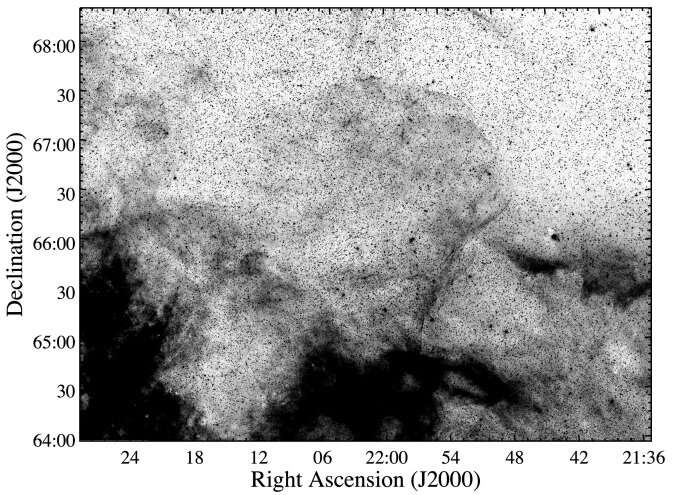August 24, 2020 report
New large optically bright supernova remnant discovered

Astronomers have reported the discovery of a new galactic supernova remnant (SNR) in the Cepheus constellation. The newly detected SNR is relatively large and optically bright, but faint in radio and X-ray bands. The finding is detailed in a paper published August 13 on the arXiv pre-print repository.
SNRs are diffuse, expanding structures resulting from a supernova explosion. They contain ejected material expanding from the explosion and other interstellar material that has been swept up by the passage of the shockwave from the exploded star.
Studies of supernova remnants are important for astronomers, as they play a key role in the evolution of galaxies, dispersing the heavy elements made in the supernova explosion into the interstellar medium (ISM) and providing the energy needed for heating up the ISM. SNRs are also believed to be responsible for the acceleration of galactic cosmic rays.
Now, a team of astronomers led by Robert A. Fesen of the Dartmouth College in Hanover, New Hampshire, reports the discovery of a large SNR in the Milky Way galaxy. The SNR, designated G107.0+9.0, was identified through its optical emission using a 130-mm telescope at the New Mexico Skies Observatory, as part of the MDW Hydrogen-Alpha Sky Survey. G107.0+9.0 was initially classified as a faint planetary nebula, however, some studies of this source suggested that it might be an unrecognized SNR.
"In this paper, we present evidence that this nebula, G107.0+9.0, is a previously unrecognized galactic SNR based on its optical emission properties and structure as determined from wide and narrow Hα, [O III] and [S II] images plus low-dispersion, long-slit spectra," the astronomers wrote in the paper.
The observations show that G107.0+9.0 has a near spherical shape, with a diameter between 244 and 326 light years, which makes it one of the largest galactic SNRs known to date. The SNR is estimated to be located some 4,900-6,500 light years away from the Earth.
G107.0+9.0 turns out to have an extensive optical emission structure. High-resolution images uncovered a complex set of thin and overlapping filaments along the SNR's northern, western, and southwestern limbs, with few filaments bright in [O III] emission.
According to authors of the paper, the presence of both radiative and non-radiative filaments found throughout the source, and the coincidence of sharp hydrogen-alpha filaments immediately ahead of [O III] bright emission along its northwestern limb, as well as its spherical shape, confirm the SNR status of G107.0+9.0.
Moreover, the morphology of G107.0+9.0's filament rich optical emission structure are also indicative of the object's SNR nature.
"Its numerous and delicate filaments seen along its northern and western boundary are matched by few other galactic remnants. Dozens of long and gently curved filaments indicate the remnant's shocks are expanding into large-scale, local interstellar regions with varying preshock densities," the researchers explained.
The scientists added that follow-up moderate to high-dispersion spectroscopy on bright stars lying behind G107.0+9.0 could be essential in order to provide more insights into the properties of this SNR.
More information: G107.0+9.0: A New Large Optically Bright, Radio and X-Ray Faint Galactic Supernova Remnant in Cepheus, arXiv:2008.05620 [astro-ph.HE] arxiv.org/abs/2008.05620
© 2020 Science X Network





















